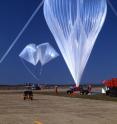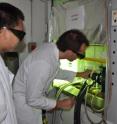New discovery could pave the way for identification of rogue CFC release
A new discovery by scientists at the Universities of East Anglia and Frankfurt could make it possible in future to identify the source of banned CFCs that are probably still being released into the atmosphere. Using mass spectrometers, the researchers analysed air samples collected in the stratosphere by balloons belonging to the French space agency, the Centre National d'Etudes Spatiales (CNES). They discovered the largest chlorine isotope enrichment ever found in nature.
CFCs were banned in most countries because of their depletion of the ozone layer. Due to their long lifetimes, their atmospheric concentrations are expected to decline only slowly. However, the observed decline is even slower than what scientists predicted. The likely reasons for this are the continued use of CFCs and emissions from old refrigerators, air conditioning units and waste disposal.
"We are particularly excited by this discovery because this is a totally new observation for atmospheric chlorine," said Johannes Laube, of the University of East Anglia's School of Environmental Sciences.
"Potentially, the technique we developed could enable us to identify remaining sources of CFCs in the atmosphere and to measure human contributions to naturally occurring ozone-depleting gases."
The measurements were obtained from samples brought back by the stratospheric balloons, but the research group has now started experiments in a laboratory where they replicate the reactions in the stratosphere.
"We try to measure the isotope effect in our laboratory in simulated stratospheric conditions," says Dr Jan Kaiser, also of the School of Environmental Sciences. "We do need to do more method development work and gather additional information before we can identify the fingerprint of the isotope in this way, but this discovery opens the door to that possibility."
Source: University of East Anglia
Other sources
- Ozone depletion: Paving the way for identification of rogue CFC releasefrom Science DailyThu, 2 Sep 2010, 19:07:36 UTC
- New discovery could pave the way for identification of rogue CFC releasefrom PhysorgThu, 2 Sep 2010, 18:21:36 UTC

